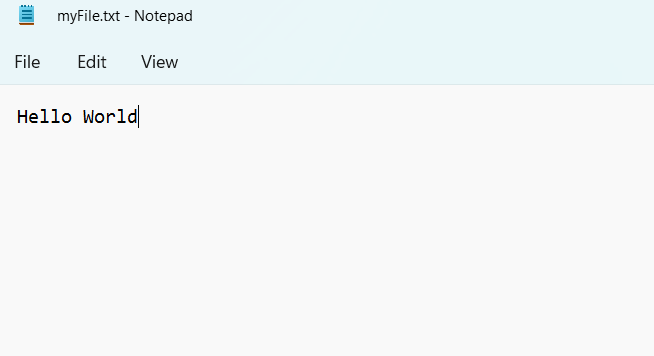C# provides the File class which is used to perform various operations like creating a file, opening a file, reading and writing a file etc.
What are Files and Directory ?
A file is a named location that can be used to store related information. For example,
program.cs is a C# file that contains information about the C# program.
A directory is a collection of files and subdirectories. A directory inside a directory is known as a subdirectory.
Working with Files in C#
C# provides a System.IO namespace that contains several classes that are used to perform operations on files and dictionaries.

The above image shows some of the classes under the System.IO namespace. Among these classes, we will learn about the File class and it's methods to work with files in C#.
C# File Class and Its Methods
The File class provides us built-in methods that allow us to perform input / output operations on files. Some of the commonly used methods are:
| Methods | Use |
|---|---|
Create() |
Create or overwrite a file in the specified path. |
Open() |
Opens a FileStream on the specified path with read / write access |
WriteAllText() |
Create a new file, writes the specified string to the file, and then closes the file |
ReadAllText() |
Opens a text file, reads all lines of the file, and then closes the file. |
Copy() |
Copies an existing file to a new file. Overwriting a file of the same name is not allowed. |
AppendAllText() |
Opens a file, appends the specified string to the file, and then closes the file. If the file does not exist, this method creates a file, writes the specified string to the file, then closes the file. |
Create a File in C#
We use the Create() method of the File class to create a new file in C#. For example,
// create a file at pathName
FileStream fs = File.Create(pathName);
Here, the File class creates a file at pathName.
Note: If the file already exists, the Create() method overwrites the file.
Example: Create a File
using System;
using System.IO;
class Program
{
static void Main()
{
// path of the file that we want to create
string pathName = @"C:\Program\myFile.txt";
// Create() creates a file at pathName
FileStream fs = File.Create(pathName);
// check if myFile.txt file is created at the specified path
if (File.Exists(pathName))
{
Console.WriteLine("File is created.");
}
else
{
Console.WriteLine("File is not created.");
}
}
}
Output
File is created.
In the above example, we have created a file myFile.txt at C:\Program directory using the Create() method.
After creating the file, notice that we have used the Exists() method to check whether the file myFile.txt exists or not.
Note: The "@" in front of "C:\Program\myFile.txt" indicates this as a verbatim string. We use verbatim string to tell the compiler to ignore escape character \.
Open a File
We use the Open() method of the File class to open an existing file in C#. The method opens a FileStream on the specified file. For example,
using System;
using System.IO;
class Program
{
static void Main()
{
string pathName = @"C:\Program\myFile.txt";
// open a file at pathName
FileStream fs = File.Open(pathName, FileMode.Open);
}
}
In the above example, notice the code,
// opens the file at pathName
FileStream fs = File.Open(pathName, FileMode.Open);
Here, the Open() method opens myFile.txt file. Here, FileMode.Open specifies - open the existing file.
Note: A file stream is a sequence of bytes used to hold file data. Every file contains at least one file stream.
Write to a File
We use the WriteAllText() method of the File class to write to a file. The method creates a new file and writes content to that file.
Let's see an example to write to a file in C#.
using System;
using System.IO;
class Program
{
static void Main()
{
string pathName = @"C:\Program\myFile.txt";
// create a file at pathName and write "Hello World" to the file
File.WriteAllText(pathName, "Hello World");
}
}
In the above example, notice the code,
File.WriteAllText(pathName, "Hello World");
Here, the WriteAllText() method creates myFile.txt at C:\Program directory and writes "Hello World" to the file.

The above image shows the myFile.txt file that contains the text "Hello World".
Note: If the file already exists, the WriteAllText() method overwrites the file.
Read a File in C#
We use the ReadAllText() method of the File class to read contents of the file. The method returns a string containing all the text in the specified file.
Let's read the content of the file myFile.txt where we had written "Hello World".
using System;
using System.IO;
class Program
{
static void Main()
{
string pathName = @"C:\Program\myFile.txt";
// read the content of myFile.txt file
string readText = File.ReadAllText(pathName);
Console.WriteLine(readText);
}
}
Output
Hello World
In the above example, notice the code,
// read the content of myFile.txt file
string readText = File.ReadAllText(pathName);
The ReadAllText() method reads the file myFile.txt and returns "Hello World".
